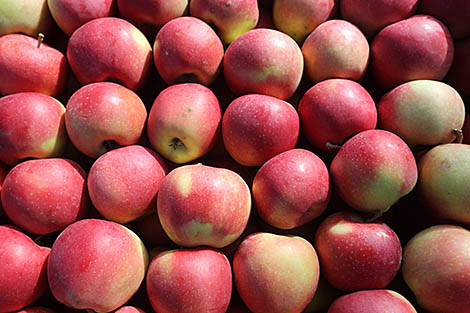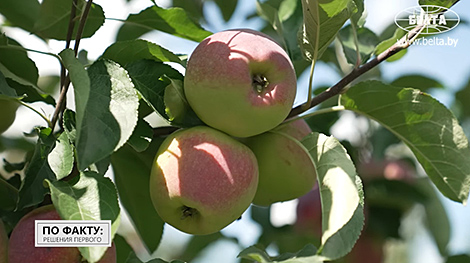News & Events in Belarus
Lukashenko calls to revive apple farming in Belarus

An archive photo
In August 2022, Aleksandr Lukashenko visited the Vitaly Kremko production cooperative during his trip to Grodno District. The president inspected the progress in horticulture and praised the results. Afterwards, he held a meeting on orchards and provision of the domestic market with fruits and vegetables. The main goal is to increase the production of domestically made food. In the new episode of BelTA’s YouTube project “After the Fact: Lukashenko’s Decisions” we will tell you how much it costs to plant one hectare of an orchard? How do scientists create new varieties of apples? What risks do gardening farmers face?
How long does it take to get a new variety of apples?
Last year, Belarus harvested about 210,000 tonnes of apples. It was almost 40,000 tonnes more than in 2021. Brest Oblast turned out to be the country’s leader in apple farming. Some of the output was sent to retail, some was stored for winter and the rest was exported. All this would be impossible without the work to improve technologies. This is what the Institute of Fruit Growing is doing. Scientists say that in horticulture it is important to think several decades ahead. Otherwise, it is impossible to get the maximum yield from a new variety.
“It takes up to 15 years to breed a new variety. As luck would have it. Then you have to polish the technology for that variety. You plant it as a production-experimental orchard to make sure the new variety complies with the technological regulations and work out some other things,” said Dmitry Martsinkevich, Head of Storage and Processing at the Institute of Fruit Growing.

The Institute of Fruit Growing grows winter-hardy varieties resistant to diseases. Not only for the sake of science but for profit too. Scientists hail such varieties as Alesya, Vesyalina, Diamant, Belorusskoye Sladkoye, Zorka.
“We have a storage facility with a capacity of up to 200 tonnes. This year we might put into operation an even larger storage facility. In addition to breeding and technological tasks, we also send these fruits to retail. In addition to breeding, we work on storage technologies. We study agro-technical approaches and their impact on fruit preservation, and also the storage technologies themselves in order to extend the terms of apple sales,” Dmitry Martsinkevich noted.

Why are Belarusian scientists working on apple storage technologies?
Apple storage and cultivation technologies are not kept secret. The Institute of Fruit Growing shares this knowledge with large farms and small farmers. Thanks to this, some agricultural organizations in Belarus unseal their storage facilities as late as April when people run out of their stocks of fruits, and retail is ready to buy them at higher prices.
“Indeed, at the end of summer apples are cheap. But in winter, or even better in spring, prices are much higher. You just need to know how to store apples. And you will get 150-200% profitability. It is way more profitable than hydrocarbons. We have enough winter varieties. Belarusians happily buy home-grown apples at reasonable prices. We can make good money on export,” Aleksandr Lukashenko noted during a working trip to Grodno Oblast and a visit to the Vitaly Kremko production cooperative in August 2022. “The question arises: are there enough storage facilities? Without storage facilities, there is no point in developing horticulture. Planting orchards makes sense only if you have storage facilities.”

Last year 122,000 tones of fruits and vegetables were put into storage. Of these, about 25,000 tonnes were apples. Apple export licensing was in force for almost three months. This allowed increasing the share of home-grown apples on the market by more than 19%.
What varieties of apples are popular with Belarusians?
A few years ago the scales tipped in favor of foreign varieties. Such varieties as Champion, Ligol, Honey Crisp began to carve a larger share in our market.
These varieties are quite tasty, sweet. The seelction processes initially differed in their goals and objectives. Belarusian selection prioritizes stability and winter hardiness, foreign varieties - taste qualities,” Dmitry Martsinkevich said.
Even scientists will not be able to say which varieties are better - domestic or foreign ones. All apples are different, in terms of taste and color. Every group of varieties has its own disadvantages and advantages. Belarusian varieties are more resistant to diseases. This means they require less chemical treatments. This saves a lot of money. "Chemistry" is expensive and makes apple growing more expensive. This cannot but affect apple prices in retail.

“There were cases when foreign varieties did not “wake up” in spring and had to be cut down. At the same time, the farms that had Belarusian varieties as a safety net made profit. Therefore, it is impossible to come to a conclusion in terms of which group of varieties to grow,”Dmitry Martsinkevich noted.
The yield of a garden starts in the nursery. Every detail matters: the quality of the planting material, soil, the pruning in the first years and the distribution of fruit buds on skeletal branches. It is all done by a person. Every tree requires special care.

How to succeed in apple growing. Farmer shares his secrets
Belarus is implementing the state program Agribusiness 2021-2025. Several hundred hectares of young orchards are planted in Belarus every year as part of the program. The government runs a grant competition to finance promising projects. The most active participants are from Brest Oblast and Grodno Oblast. Horticulture is well-developed in these regions. The priority is given to winter and late winter varieties. These are Alesya, Belorusskoye Sladkoye, Verbnaye and many more. About half of the volume of apples is grown by farmers. For example, Igor Vetlov has been engaged in horticulture for about thirty years. He started by growing seedlings.
“I started with 2,500 seedlings. A neighbor came and asked me to sell him some. I sold him ten seedlings below the market price. I brought the money to my mother and she asked if I realized how much money I earned. It was $50 in equivalent. Back then we earned very little. Both my mother and I worked. I sold all those 2,000 seedlings at the market place. It was the first time I held big money in my hands. 07.57 The next year I grew 16,000 seedlings, and 65,000 a year later,” Igor Vetlov recalled.

Belarus launched its fruit growing program in 2004. It was developed by scientists and specialists of the Agriculture and Food Ministry. Then the task was set to produce 800,000 tonnes of fruits and berries annually by 2010. The goal was to reduce imports three times. In 2003 Belarus exported 9,000 tonnes of apples, while imported ten times more. Considerable funds were allocated to develop technological infrastructure of farms, construct storages and nurseries. At that time Igor Vetlov's farm produced 250,000 seedlings. Everything sold out. The farmer, however, dreamed of an orchard. His dream came true when he got 100 hectares of land. He traveled around all farms in Belarus and also those in near and far abroad to adopt the best practices. He started with an orchard of 12 hectares. Now he has 50 hectares.
I grow a lot of them, up to 500,000 units of parent stock. I do not produce a lot of seedlings. The demand is low. When this business boomed, there were a lot of nurseries across the country. Today I know only two of them, two except me. The nursery brings low profitability, since we are within a risky farming zone. You plant stock, invest money and may get it frozen in winter,” Igor Vetlov said.
Apple harvest in Vetlov's farm lasts for a month and ten days, but no longer. Otherwise the harvest can be lost. The farmer hands over 300 tonnes to the stabilization funds. He has recently leased two more tractors.

“I got two more tractors on lease. I have a total of nine tractors. For most of the year I keep my tractors in the yard. During the harvest season all of them are used to the full. Once ripe, apples need to be collected very quickly. I mean, you cut the apple, do an iodine test, and if it is ripe, you have three days to harvest that variety. For example, I have 600 tonnes of the Alesya variety, and I have only three days to harvest it. If I fail to do it, these apples will not store well. I will not be able to sell them,” Igor Vetlov said.
Apple industry has never been an easy business. Apple growers face problems, too. For example, it may happen that farmers are ready to sell their product, but retailers are not ready to buy. Not every storage facility is able to preserve the quality of goods for a long period of time.
“I need to sell a truckload every two and a half days. Otherwise, my apples will start rotting. The situation would be different if we had more CA storage facilities. There are very few of them in the country. We built storage facilities that we could at that time. We could not do more. We used foam and installed refrigeration equipment. My apples store well till mid-January, no longer,” Igor Vetlov said.

Why Lukashenko says Belarusian apples are better than Polish ones
Two thirds of apples in Belarusian retail chains are labeled Made in Belarus. Before getting to the store shelves, the fruit is checked for dozens of quality and safety indicators: toxic elements, pesticides, radiation, and nitrates.
“I will be honest I have never been involved in horticulture before. When I became President, I started to look into details. We import apples, especially from Poland. His (the farmer's) apples are better than any Polish ones. The main thing is that they are more organic. He knows very well that if he markets something of poor quality, he will be held responsible,” the head of state said during the national cleanup day this year.
Aleksandr Lukashenko planted an apple orchard in his hometown during the recent national cleanup day. Talking to the farmer, the president once again emphasized the quality of Belarusian products. The orchard has over 400 apple trees of the Belorusskoye Sladkoye and Syabryna varieties. Local school students will take care of the orchard. The president has repeatedly mentioned the need to plant apple orchards and assign them to educational institutions.
“I criticized the government that our schools and other educational institutions do not cultivate apple, plum, pear trees at all. This is something we always used to do on school grounds. I do not mean that school gardens should replace commercial orchards. This move is necessary to get children engaged in work, to make them realize that an apple costs money, that it does not grow on the internet. The initiative to plant orchards on school grounds has remained on paper however. You will be held responsible for the failure to implement this project,” the head of state said at the meeting to discuss orchard development and the provision of the domestic market with fruit and vegetable products in Grodno District in August 2022.








 print version
print version make home page
make home page add to bookmarks
add to bookmarks

